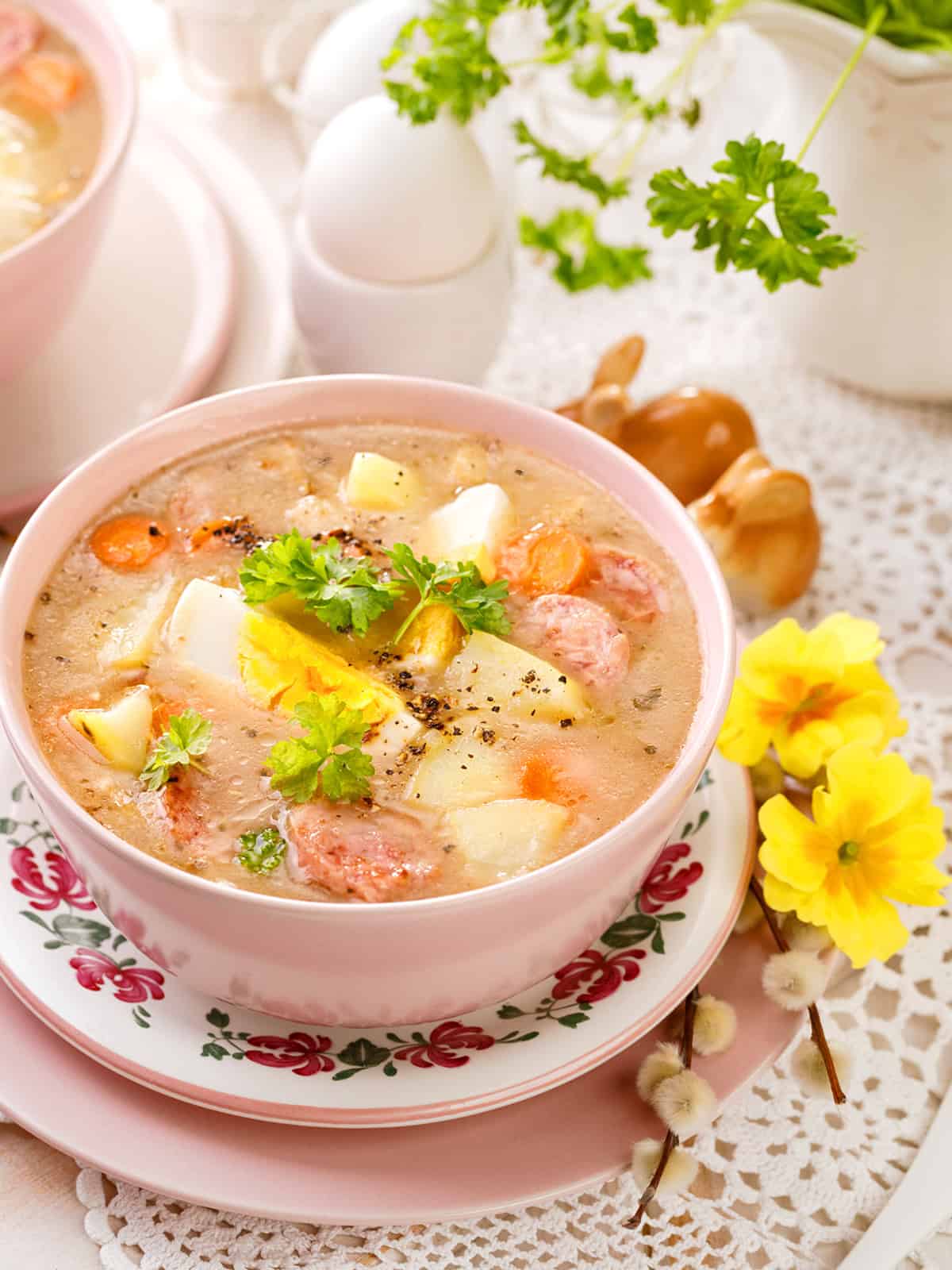Żurek (Polish Sour Rye Soup)
This post may contain affiliate links. See my disclosure policy.
The famous soup from Poland renowned for its rich and complex flavors that pair sour and smoky, sweet and savory, with a delicious blend of meats, vegetables, and spices. Its star ingredient is a fermented rye flour starter known as Zakwas na Żurek, which gives it its hallmark sour flavor and is super easy to make yourself. This authentic Zurek recipe is traditionally served at Easter time but is likewise enjoyed all year round!

Why I Love Żurek
Being from Germany and just a half day’s drive to the Polish border from my hometown of Stuttgart, we would take weekend trips over there to explore the towns and sights, enjoy Polish food at the local restaurants, and bring home Polish ingredients from the supermarkets. And just two hours further from the border we would be in present day Wroclaw, formerly Breslau when it belonged to Germany until after WWII, which is where my Oma and Opa were from. It’s a beautiful city with incredible architecture that Poland has done a commendable job of restoring after the resulting damage from the war and there ongoing collaborations between Poland and Germany to honor and preserve the city’s historic German heritage. Even when my Oma and Opa lived there, there was a sharing of culinary influences between that area of Germany and Poland and the “sour” influences of such soups as Żurek were well known to my grandparents. These dishes and influences were ones that I grew up with and cherish and they are very sentimental to me. Żurek soup in particular is one that I love and is one of Poland’s most popular soups. Let me introduce you this wonderful Polish sour rye soup.

What is Żurek?
Żurek, or simply Żur, is a traditional Polish soup made with a fermented rye flour starter called Zakwas na Żurek (some refer to it as Zakwas Żytni but that refers to rye sourdough starter, not the liquid version that is used specifically for zurek soup). This rye starter gives the soup its hallmark tangy-sour flavor. The word ‘żurek’ is a diminutive of the word ‘żur’, which is believed to come from the germanic word ‘sur’, meaning sour. Zurek is also made with sliced sausage, most commonly either a white kielbasa sausage known as Biała Kiełbasa, which is a fresh, non-smoked sausage, or smoked kielbasa sausage. Other traditional ingredients include bacon, potatoes, celery root, carrots, onions, and seasonings, specifically marjoram, and boiled eggs. Ingredients differ slightly by region and some areas serve it hollowed out bread bowls. Zurek is a popular soup to serve at Easter (it’s nicknamed “Polish Easter soup”) but it is enjoyed all year round.
Its origins can be traced back several centuries when it began as a staple dish for peasants as a way to use up leftover ingredients and make do with whatever they had on hand. When meat wasn’t available the depth of umami flavor from the fermented rye flour would suffice. And as is true of so many dishes once looked down on as “peasant food” (e.g., Beef Bourguignon, Coq Au Vin, Scotch Broth, Solyanka, Ratatouille, etc), zurek is now embraced across all walks of life and is celebrated as an important part of Poland’s heritage.
This fermented rye flour soup is a traditional Polish dish but it’s also enjoyed, with slight differences, in the Czech Republic, Slovakia and Belarus. It likewise has ties to my ancestral region of Silesia Germany where my Oma and Opa were from until having to leave after WWII. That area is now part of Poland but even back in days it was part of Germany there was a fusion of German and Polish cuisine, both influencing each other in the areas along the border, and that could be seen in the regional cuisine of Silesia (e.g., “sour” soups and other dishes, the popular use of poppy seeds in baking, stuffed cabbage rolls, etc). My Oma and Opa and their parents enjoyed a soup very similar to Zurek, which they called Vollkornrogenmehlsuppe (rye flour soup).
In generations past you could go into a typical Polish kitchen and find glass jars or ceramic crocks covered with cloth containing a murky beige-colored liquid. And that would be the fermented rye flour starter. Polish cooks would rotate through these jars, always having a new batch going, to have on hand. This fermented starter was not only used to make zurek but would also be used to thicken sauces and gravies and added to other soups for a boost of umami richness. Nowadays you can buy ready-made zakwas na zurek in many of the supermarkets and as easy as it is to make your own, many just grab some from the store for convenience. But even if you had access to store-bought zakwas I would still strongly encourage you to make your own because it’s super easy, cheaper, and tastes better!

Zurek Ingredients and Substitutions
There are a few foundational ingredients that define zurek and cannot or should not be omitted or substituted, such as the fermented rye flour starter. Here are the ingredients you’ll need to make zurek along with recommendations for substitutions:
- Fermented Rye Flour Starter (Zakwas na Żurek): Without this there is no zurek soup. This is what creates its hallmark sour flavor. This cannot be purchased outside of Eastern Europe unless you have a local Polish deli with an owner that sells it (it never hurts to ask). But don’t worry because you can make it yourself. And not only is it incredibly easy, homemade tastes much better. All it takes is some planning ahead because it takes 5-7 days. See my recipe for homemade Zakwas na Zurek.
- Biała Kiełbasa (White Kielbasa Sausage) or Smoked Kielbasa Sausage: Both of these are traditional choices depending on the particular region. Unlike smoked kielbasa which is readily available most places, the white kielbasa is fresh, uncured and unsmoked. It’s a pork sausage seasoned with garlic and marjoram. The casings are removed, the sausage is sliced into rounds, and they are added to the soup. It’s likewise nearly impossible to find outside of Poland unless, again, you have a very well-stocked Polish deli nearby. An alternative to biała kiełbasa that you can consider is German Weisswurst. While this is traditionally made with veal and not pork, there are similarities in its preparation as well as its seasoning profile. These are likewise prepared by removing the casings and simmering the sausages. And as its name denotes, these sausages are likewise white in color. The other traditional choice is smoked kielbasa sausage which fortunately is widely available. If you don’t have access to any of these options, you can use another seasoned sausage of your choice.
- Boczek (Smoked Pork Belly): This comes in a thick slab that you slice and dice. You can substitute Speck if you can find it, or use thick cut smoked bacon.
- Celeriac/Celery Root: Being from Germany, this is an ingredient I am very familiar with. Most of continental Europe favors celeriac over stalk celery. The flavor of celeriac is deeper, mellower, and sweeter than stalk celery and it contributes what I always refer to in my German soup recipes that call for it as that “characteristic German flavor” that you just can’t achieve without it. Most grocery stores carry it though you may have to search more than one. Ask a worker in the produce section if you can’t find it. I very strongly recommend sourcing the celeriac for the most authentically tasting zurek. But if it’s impossible, you can substitute stalk celery.
- Parsley Root: I have never been able to find this in the U.S. and do not even recall seeing it anywhere in Western Europe. Instead, I have had to grow it myself in my garden (a variety called Hamburg parsley)! It’s commonly used in Central and Eastern European soups. There is no substitute for parsley root. Parsnips look very similar but they’re not the same and do not taste the same. If you can find parsley root, use it, otherwise simply omit it.
- Carrots, Potatoes, Leek, Onions, Garlic: These are readily available anywhere.
- Prepared Horseradish: This is a touch that many Polish home cooks like to add to their zurek. It not only adds a great flavor, it also adds a nice contrasting spiciness to the sour soup. You can omit it if you prefer.
- Sour Cream: Some recipes call for heavy cream but the traditional recipes that I’ve seen growing up in Germany around Polish people and in visiting Poland use sour cream. It’s a hallmark ingredient in Eastern European cuisine and a common addition to soups and sauces. It adds creaminess and added tang to the zurek.
- Boiled Eggs: These are nestled in the soup after ladling it into individual bowls. I’m not sure if the addition of eggs is why it became popular to serve for Easter or if the eggs were later added because it became a tradition to serve at Easter, but in any case they are a traditional addition to the soup.
- Bay Leaf: These are standard in many soups and added a nice earthy, herbal flavor.
- Marjoram: As with the celeriac, marjoram has a distinctly old-school European quality to it that I love, a flavor that’s very characteristic of many traditional German recipes and likewise many Eastern European dishes. Unlike oregano which is quite sharp and pungent, marjoram is milder and sweeter. You can substitute oregano if you wish (though use less of it) but if you’re really interested in achieving an authentic flavor, you really should use marjoram. It’s a spice that any cooking enthusiast should have regardless. So do yourself a favor and get a small jar if you don’t already have it.
- Salt and Pepper: Aside from the bay leaf and marjoram these are the only seasonings you need to make zurek because it derives most of its flavor from the fermented rye flour (which is typically already seasoned), the very flavorful meats, and the vegetables.
As with most dishes from around the world, sourcing the correct ingredients to best of your ability is key to achieving an authentic flavor and experiencing the dish in the way it’s meant to be. And it’s then that you can truly appreciate the details and intricate differences in the culinary cultures of the world. That’s my passion and it’s what spurred me to create The Daring Gourmet back in 2013, as a place to share my love for authentic dishes from nations all around the globe.

Zurek Recipe
The first step to making Zurek is to make the fermented rye flour starter known known as zakwas na zurek. This takes 5-7 days, so be sure to plan ahead. Check out my recipe for Zakwas na Zurek. Once that’s ready to go, you’re ready to make your zurek. Here’s how:
- Fry the speck or bacon in a heavy soup pot or Dutch oven until the fat is rendered and crispy. Add the sliced kielbasa and dry until just starting to brown. Transfer to a bowl, leaving the bacon grease in the pot.
- Add the onions and cook until they’re soft and translucent, 4-5 minutes. Add the leek and garlic and cook for another 2 minutes. Add the carrots, celery root, parsley root or parsnip, and potatoes and cook for another 5 minutes. Return the bacon and kielbasa to the pot and add the chicken broth, marjoram, salt, pepper and bay leaf. Bring it to a boil, reduce the heat to a simmer, cover and simmer for 30 minutes.
- Thoroughly stir the fermented rye starter before measuring it out. Add the starter to the soup and stir. Taste the soup and decide if you’d like it a little more sour, in which case add some more starter. Let the soup simmer for another 10 minutes. Discard the bay leaf. Note: If you want the soup thicker without adding more of the sour, scoop out some of the flour from the bottom of the jar, place it in a small bowl, stir some of the hot broth from the soup into it, then stir the flour/broth mixture into the soup.
- Place the sour cream in a bowl and stir in a ladleful of the soup, stir to thoroughly combine, and then add the sour cream mixture to the soup. Let it heat through. Add more salt, pepper and horseradish according to taste.
- To serve, ladle the soup into bowls, place the eggs on top of the soup, and sprinkle over some cracked pepper or chopped or dried marjoram.
Storage and Freezing Polish Sour Soup
Zurek will keep in the fridge for 3-4 days. Gently reheat on the stovetop or in the microwave. Zurek does not freeze well because potatoes tend to become grainy when frozen and thawed and the sour cream curdles.
Enjoy!

For more traditional soups from around the world try my:
- Hungarian Goulash
- Harira
- Solyanka
- Wonton Soup
- New England Clam Chowder
- Japanese Mushroom Vermicelli Soup
- Caldo Verde
- Masoor Dal
- Scotch Broth
- Matzo Ball Soup
- French Lentil Soup
- Minestrone Soup
- Avgolemono
- Cullen Skink
- Hungarian Mushroom Soup
- Pozole Rojo
- Wonton Soup
- German Potato Soup
Save This Recipe

Żurek (Polish Sour Rye Soup)
Ingredients
- 7 ounces speck or bacon (about 8 slices of bacon), diced
- 14 ounces white kielbasa sausage or smoked kielbasa sausage (if using white kielbasa, see Note below), sliced
- 1 medium yellow onion , chopped
- 1 cup chopped white part of a leek
- 1 clove garlic , minced
- 2 large carrots , diced or sliced
- 1 cup diced celery root (celeriac)
- 1 medium parsley root , (can substitute parsnip) diced
- 2-3 firm yellow potatoes (e.g. Yukon Gold) , (about 12 ounces) diced
- 7 cups chicken broth
- 2 teaspoons prepared horseradish (start with less, taste, and add more as desired)
- 2 teaspoons dried marjoram
- 1 1/2 teaspoons kosher salt
- 1/2 teaspoon freshly ground black pepper
- 1 bay leaf
- 1 cup zakwas na zurek (fermented rye flour starter) , plus more to taste (click link for recipe – this takes 5-7 days to make, so plan ahead!)
- 1/2 cup sour cream
- 4 boiled eggs , shells removed and cut in halves or quarters
Instructions
- In a heavy soup pot or Dutch oven, fry the speck or bacon until the fat is rendered and it is crispy. Add the sliced kielbasa and dry until just starting to brown. Transfer to a bowl, leaving the bacon grease in the pot.
- Add the onions and cook until soft and translucent, 4-5 minutes. Add the leek and garlic and cook for another 2 minutes. Add the carrots, celery root, parsley root or parsnip, and potatoes and cook for another 5 minutes. Return the bacon and kielbasa to the pot and add the chicken broth, marjoram, salt, pepper and bay leaf. Bring it to a boil, reduce the heat to a simmer, cover and simmer for 30 minutes.
- Thoroughly stir the fermented rye starter before measuring it out. Add the starter to the soup and stir. Taste the soup and decide if you'd like it a little more sour, in which case add some more starter. Let the soup simmer for another 10 minutes. Discard the bay leaf.Note: If you want the soup thicker without adding more of the sour, scoop out some of the flour from the bottom of the jar, place it in a small bowl, stir some of the hot broth from the soup into it, then stir the flour/broth mixture into the soup.
- Place the sour cream in a bowl and stir in a ladleful of the soup, stir to thoroughly combine, and then add the sour cream mixture to the soup. Let it heat through. Add more salt, pepper and horseradish according to taste.
- To serve, ladle the soup into bowls, place the eggs on top of the soup, and sprinkle over some cracked pepper or chopped or dried marjoram.



















Unique and very delicious. This is definitely a soup I’ll make again.
Thank you so much, Katrina, I’m happy you enjoyed it!
I’ve made Żurek many times before and your recipe is the best! Thank you. It’s the first time I let the starter ferment for seven days, and I hadn’t used celery root in this before now. I found it slightly greasy at the end with the rendered bacon fat, but you need that fat to cook the veggies before adding the stock. Next time I may chill it overnight so the fat rises and solidifies. Skimming it off the top would solve that issue. Żurek is one of the best soups imagined, and your recipe is excellent!
Oh I am so thrilled to hear that, Thomas, and I really appreciate the feedback, thank you so much!
Oh Kimberly, I am SO excited to see this one! My family is Polish. My grandparents immigrated to the U.S. and my grandmother made the most wonderful food when I was young. Sadly most of her recipes were never passed down to my mom and I have spent years trying to identify and find recipes for the dishes that I remembered her making. Zurek is one of them and I have zero doubt that I’m going to love your recipe because I have made and loved so many others. They are always spot on, very authentic, and I love reading all the information you write about the back story and history of these dishes. I look forward to making this soon, just need to get some rye flour to get the zakwas na zurek started!
Thank you so much for the compliment, Alicia, I really appreciate that! <3 I'm excited that you're going to try the zurek, I hope you enjoy it!